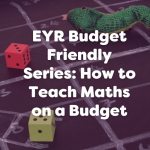Early Years Education is defined by the EYFS (Early Years Foundation Stages). This EYFS curriculum is split into 7 areas of learning: Communication & Language, Literacy, Expressive Arts and Design, Understanding the World, PSED, Physical Development and Maths. Teaching within these specific areas is vital for children’s overall development as it contributes to later success both academically and in general life. In this blog we will focus on EYFS Maths, exploring its role in developing critical thinking and problem solving skills in young children and delving more into the requirements around the subject and how it is taught in the Early Years.

What is Maths in EYFS
At its foundation, Maths in the EYFS introduces little learners to concepts including counting, shapes, measurements and patterns. These early mathematical concepts can occur during “lessons” but more often than not, come about during play and exploration.
This not only supports children’s general critical thinking and problem solving skills but lays the foundation for later mathematical thinking, inside and outside the classroom in everyday life.
How is Maths taught in the early years
There is no specific way to teach Maths as defined by the EYFS Framework. Teaching can therefore be tailored to suit the needs of the individual children. In early years settings this can take many forms, some examples of which are outlined below – however the main focus is always on creating an environment that is rich in opportunities for mathematical thinking and development.
- Playful exploration: this refers to providing play opportunities for children to be able to encounter maths concepts organically for example sorting loose parts
- Maths in storytelling: combining the two areas of learning can be done easily and is facilitated in most stories. Children can be prompted to count the number of objects on a page for example
- Incorporating music: this is a tried and tested way of teaching maths – we are all well versed in the nursery rhymes “10 green bottles” or “5 in the bed”
- Integrated learning: this simply refers to incorporating maths into various aspects of a child’s daily experiences whether it be counting the number of pasta pieces on their plate for lunch or identifying patterns in their environment

Key areas of early maths learning
Early Maths learning is further split into a few key areas that play a crucial role in laying the foundation for mathematical understanding. These include the following as well as the details provided in the EYFS framework:
- Understanding and using numbers: “children should develop a deep understanding of the numbers to 10, the relationships between them and the patterns within those numbers”
- Counting: “children should be able to count confidently”
- Spatial reasoning skills: “including shape, space and measuring”
- Calculating simple addition and subtraction problems
Requirements for Maths in the Early Years
As outlined briefly above, the EYFS statutory framework states that children should be able to count confidently, develop a deep understanding of the numbers to 10, the relationships between them and the patterns within those numbers.
It also states that practitioners should provide “frequent and varied opportunities to build and apply this understanding”. Practitioners should also support children to “develop positive attitudes and interests in mathematics, look for patterns and relationships, spot connections, ‘have a go’, talk to adults and peers about what they notice and not be afraid to make mistakes.”
Maths Learning Goals in the Early Years
At the end of their Reception Year (typically when a child has just turned 5), children will be assessed against Early Learning Goals (ELG) that are specified in the EYFS Framework. The EYFS Maths ELGs are as follows:
Number ELG
Children at this level of development will:
- Have a deep understanding of number to 10, including the composition of each number
- Subitise (recognise quantities without counting) up to 5
- Automatically recall (without reference to rhymes, counting or other aids) number bonds up to 5 (including subtraction facts) and some number bonds to 10, including double facts.
Numerical Patterns ELG
Children at this level of development will:
- Verbally count beyond 20, recognising the pattern of the counting system
- Compare quantities up to 10 in different contexts, recognising when one quantity is greater than, less than or the same as the other quantity
- Explore and represent patterns within numbers up to 10, including evens and odds, double facts and how quantities can be distributed equally
It is important to remember however that each child is unique and development does occur at different speeds for different children. What is emphasized in the EYFS Framework is the balance between achieving these goals whilst also fostering an early love for maths that will benefit children in later years.
In conclusion, EYFS Maths is the foundation for later mathematical thinking that will serve children both in the classroom and outside in their everyday lives. There is no specific guidance regarding how EYFS Maths is taught but there are key areas of learning and early learning goals for this formative age that practitioners and carers can support through various activities both inside and outside the classroom. Looking for some numeracy activity ideas? Read our blog which covers 10 fun numeracy activities for early years children.







